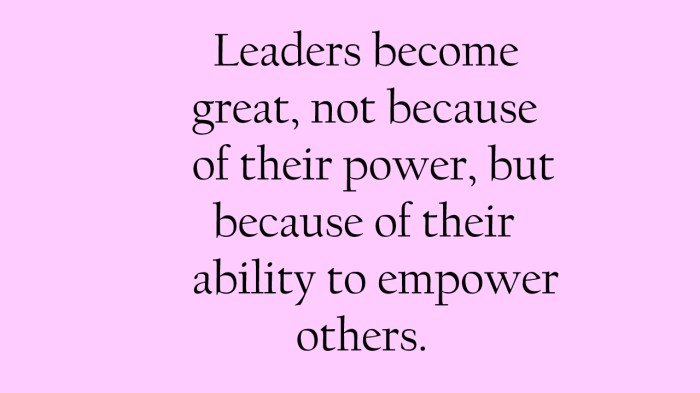How to Be a Leader takes center stage, beckoning readers into a world of leadership excellence. Learn how to cultivate essential qualities, develop skills, build a vision, and lead by example in this comprehensive guide.
Qualities of a Leader

Leadership is a complex role that requires a combination of various qualities to be effective. Some essential qualities that make a good leader include:
1. Integrity
Integrity is a fundamental quality that leaders must possess. It involves being honest, ethical, and consistent in one’s actions and decisions. Leaders with integrity earn the trust and respect of their team members, which is crucial for successful leadership.
2. Communication
Effective communication is another vital quality for leaders. It involves not only conveying information clearly but also actively listening to others. Good communication helps in building strong relationships, resolving conflicts, and aligning team members towards a common goal.
3. Empathy
Empathy is the ability to understand and share the feelings of others. Leaders who demonstrate empathy are more connected to their team members, can motivate them effectively, and create a positive work environment.
4. Decision-making
Strong decision-making skills are crucial for leaders to navigate challenges and drive progress. Leaders must be able to analyze situations, consider various perspectives, and make timely and well-informed decisions for the benefit of the team.
5. Vision
Having a clear vision and the ability to inspire others towards that vision is a key quality of a leader. Leaders who can articulate a compelling vision and motivate their team to work towards it can achieve remarkable results.Examples of successful leaders who embody these qualities include Nelson Mandela, known for his integrity and vision for equality and justice; Oprah Winfrey, who demonstrates empathy and effective communication in her leadership style; and Malala Yousafzai, who embodies courage and resilience in her advocacy for education and women’s rights.
Developing Leadership Skills

Effective leadership skills are not innate but can be developed over time through various strategies and practices. By actively seeking opportunities for growth and improvement, individuals can enhance their leadership abilities and become more effective in guiding and motivating others towards shared goals.
Mentorship and Formal Education
One way to enhance leadership skills is through mentorship and formal education. Mentors provide valuable guidance, support, and feedback based on their own experiences, helping aspiring leaders navigate challenges and develop key competencies. Formal education, such as leadership courses or workshops, can also provide a structured learning environment to acquire new knowledge and skills essential for effective leadership.
Improving Decision-Making Abilities
Leaders are often faced with making tough decisions that can impact their team or organization. To improve decision-making abilities, leaders can practice critical thinking, gather relevant information, consider different perspectives, and evaluate potential outcomes before arriving at a well-informed decision. Seeking feedback from team members or mentors can also provide valuable insights to make better decisions.
Importance of Adaptability and Resilience
Adaptability and resilience are essential qualities for leaders to navigate through uncertain and challenging situations. Leaders who can adapt to change, pivot strategies when needed, and remain resilient in the face of setbacks are better equipped to lead their team through obstacles and towards success. Developing these skills requires embracing change, learning from failures, and maintaining a positive outlook even in difficult times.
Building a Vision: How To Be A Leader

Creating a compelling vision for a team or organization is a crucial aspect of leadership. A vision serves as a roadmap, guiding the team towards a common goal and inspiring them to work towards a shared purpose.
Process of Creating a Vision
- Reflect on the values and goals of the team or organization.
- Identify long-term objectives and aspirations.
- Visualize the desired future state and the impact of achieving it.
- Create a clear and concise vision statement that encapsulates the overarching goal.
Tips for Communicating and Aligning Others with Your Vision
- Articulate the vision in a compelling and inspiring way.
- Engage team members in discussions to gain their input and buy-in.
- Lead by example and embody the vision in your actions.
- Create a sense of urgency and motivate others to work towards the vision.
Examples of Visionary Leaders
- Steve Jobs – Co-founder of Apple, who envisioned a future with user-friendly technology.
- Nelson Mandela – Fought for freedom and equality in South Africa, uniting people under a vision of democracy.
- Elon Musk – Founder of SpaceX and Tesla, with a vision of sustainable energy and space exploration.
Leading by Example

Leading by example is a crucial aspect of effective leadership. When leaders demonstrate the behaviors, work ethic, and values they expect from their team members, it sets a powerful precedent and inspires others to follow suit. By leading by example, leaders can build trust, credibility, and respect among their team members.
Significance of Leading by Example
- Establishes credibility: When leaders practice what they preach, they earn the trust and respect of their team members.
- Inspires others: By showcasing dedication, hard work, and integrity, leaders motivate their team to do the same.
- Creates a positive culture: Leading by example helps foster a culture of accountability, professionalism, and excellence within the organization.
Strategies to Inspire and Motivate Through Actions
- Set high standards for yourself: Demonstrate a strong work ethic and commitment to excellence.
- Communicate openly and honestly: Be transparent about your goals, challenges, and successes.
- Recognize and reward good behavior: Acknowledge and appreciate the efforts of team members who exemplify desired behaviors.
Stories of Leaders Leading by Example, How to Be a Leader
One example of a leader who led by example is Mahatma Gandhi. His commitment to nonviolent resistance inspired millions and led to significant social change in India.
Another example is Nelson Mandela, who demonstrated forgiveness, reconciliation, and humility during his leadership, setting an example for others to follow.
Conclusion

Mastering the art of leadership is a journey filled with growth and impact. Embrace the qualities, skills, vision, and leadership by example to inspire those around you and make a lasting difference.